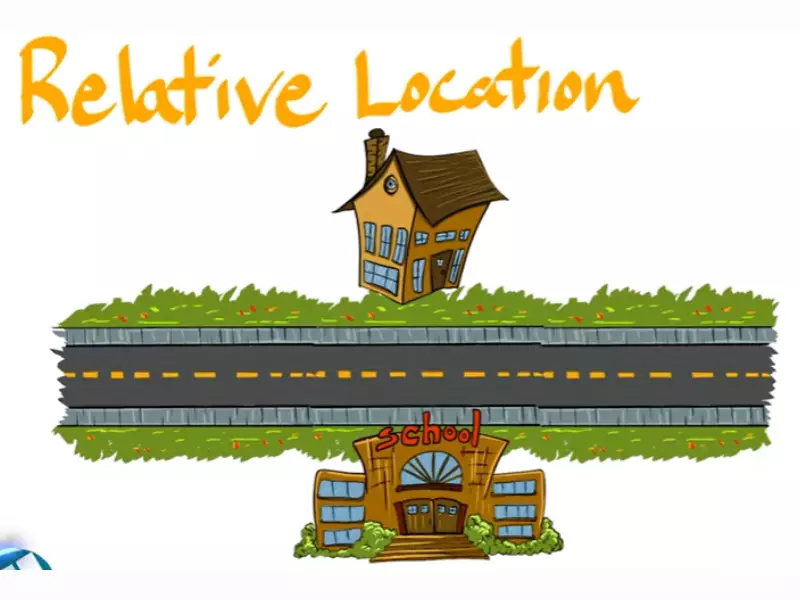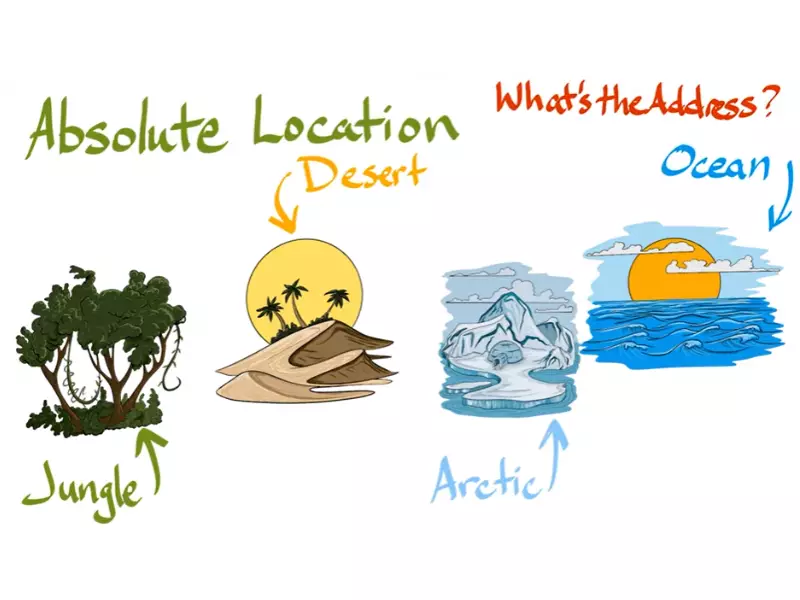In the realm of geography, the concepts of location serve as the cornerstone for understanding our world’s vast and complex layout. These concepts help us navigate through cities, discover new places, and even locate ourselves on the global map with precision. Location, in its essence, can be categorized into two distinct types: relative and absolute. Each type offers a unique lens through which we view our surroundings, providing context and coordinates that guide our interactions with the physical world.
The difference between relative and absolute location is straightforward yet fundamental to the field of geography. Absolute location pinpoints a specific point on the Earth using coordinates such as latitude and longitude, offering a universally accepted reference. In contrast, relative location describes a place’s position in relation to another, using terms that are more variable and subjective. This distinction enables us to understand and communicate locations in a variety of contexts, from detailed navigation to casual conversations about where we are.
Understanding these two types of location not only enriches our geographical knowledge but also enhances our daily experiences. Whether planning a trip, studying climate patterns, or simply trying to meet up with friends in a bustling city, the application of relative and absolute locations shapes how we interact with our environment. It underscores the interconnectedness of our world, highlighting the importance of spatial awareness in both global exploration and local navigation.

Location Basics
Location Defined
Definition and Significance
Location refers to a specific point or area on the Earth’s surface. It is a foundational concept in geography that allows us to identify, describe, and navigate the world around us. The significance of location spans across various disciplines, from geography and environmental science to urban planning and navigation. It enables us to communicate about places, understand spatial relationships, and organize information geographically.
Key Types
There are two primary types of location: absolute and relative. Absolute location provides a definitive reference to locate a place on the Earth’s surface using coordinates, such as latitude and longitude. Relative location, on the other hand, describes a place’s position in relation to other locations, offering a contextual understanding of its setting.
Absolute Location
Defining Absolute
Absolute location is determined by a specific set of coordinates—latitude and longitude—that uniquely identifies a point on the Earth’s surface. This system divides the Earth into a grid, allowing every location to be pinpointed precisely. Latitude lines run horizontally around the globe, while longitude lines run vertically, intersecting at the poles.
Uses in Real World
The concept of absolute location is applied in various real-world scenarios:
- Mapping: Creating accurate maps that allow users to find specific places.
- Navigation: GPS devices and apps use absolute location to guide users to their destinations.
- Science and Research: Scientists rely on absolute location for data collection, environmental monitoring, and study of spatial patterns.
GPS Technology
GPS technology plays a crucial role in identifying absolute locations. It uses a network of satellites orbiting the Earth to send signals to GPS receivers, allowing them to calculate the user’s exact location. This technology is essential for:
- Navigation systems in vehicles and smartphones.
- Emergency services to locate callers quickly.
- Geocaching, a recreational activity where participants use GPS to find hidden items.
Relative Location
Defining Relative
Relative location describes where a place is located in relation to other places. It provides a contextual understanding of a location’s position, using terms like “north of,” “near,” “between,” and “adjacent to.” This type of location is more variable and subjective, as it depends on the observer’s perspective and the places being referenced.
Everyday Applications
Relative location is frequently used in:
- Directions: Explaining how to get from one place to another.
- Describing places: Talking about where something is located within a city, region, or country.
- Planning: Urban and regional planning, where the relationship between different places influences decisions.
Importance in Geography
Understanding relative location is crucial for grasping the dynamics of human interactions and activities. It affects:
- Economic activities: Trade routes and market locations.
- Cultural exchanges: How cultures spread and interact through proximity.
- Environmental management: Understanding how different areas influence each other’s climate, resources, and biodiversity.
Comparing Both Types
Key Differences
The main difference between absolute and relative locations lies in precision and context. Absolute location is precise and unchanging, using a global coordinate system. Relative location is contextual, describing a place’s position based on its surroundings and can change depending on the reference point.
Interrelation
Despite their differences, absolute and relative locations complement each other in practical use. For example:
- Navigation: GPS provides an absolute location, but we often describe our destination in relative terms to others.
- Spatial analysis: Researchers might use absolute location for data collection but analyze and discuss these data in terms of their relative locations to understand patterns and relationships.
Practical Implications
The concepts of relative and absolute location extend far beyond the academic study of geography. They play a crucial role in various fields, including navigation, technology, and environmental studies. Understanding how these location types are applied can illuminate their significance in our daily lives and the broader context of human interaction with the environment.
In Navigation
Use Cases in Mapping and Travel
Absolute location, with its precise coordinates, is indispensable in the world of navigation and mapping. When you use a GPS device or a mapping app on your smartphone, you’re leveraging the power of absolute location to find your way from point A to point B. This technology relies on satellites to pinpoint your exact position on the Earth, guiding you with turn-by-turn directions to reach your desired destination.
- Mapping Applications: Digital maps use absolute location to create detailed and accurate representations of the world. Whether it’s Google Maps or Apple Maps, these tools allow users to search for specific addresses, landmarks, or points of interest, displaying the precise location on a map.
- Travel Planning: Absolute location assists travelers in planning their routes, estimating travel times, and identifying points of interest along the way. It’s particularly useful in unfamiliar areas, where relative descriptions like “next to the post office” might not be as helpful.
In Technology
Impact on Apps and Software
The integration of location-based services in apps and software has transformed how we interact with technology. Both absolute and relative locations are utilized to offer personalized experiences, from recommending nearby restaurants to alerting about local weather conditions.
- Location-Based Services: Many apps, such as ride-sharing services (Uber, Lyft) and food delivery apps (DoorDash, UberEats), rely on the user’s absolute location to function effectively. These services use GPS technology to offer real-time updates and location-based recommendations.
- Social Media: Platforms like Facebook, Instagram, and Snapchat use location features to allow users to check in at places, share location-based stories, or discover events happening nearby. This blend of relative and absolute location enhances user engagement and personalizes the social media experience.
Environmental Studies
Application in Understanding Climate and Terrain
The study of environmental science greatly benefits from understanding both relative and absolute locations. Researchers use these concepts to track climate changes, study ecosystems, and map out conservation areas. This knowledge is crucial for developing strategies to address environmental challenges and protect natural habitats.
- Climate Studies: Scientists use absolute location to monitor weather patterns and climate changes across different parts of the world. By analyzing data collected from specific coordinates, they can identify trends, predict weather events, and assess the impact of climate change on various regions.
- Terrain Analysis: Understanding the relative and absolute location of landforms is essential in terrain analysis. Geographers and environmental scientists study the relationships between different geographical features to assess their impact on ecosystems, human settlements, and environmental processes.
Mapping Conservation Areas: Both location types are crucial in identifying and mapping conservation areas. Absolute locations provide the precise boundaries of protected zones, while relative locations offer context about their placement in relation to human activities and other environmental features.

FAQs
What is Absolute Location?
Absolute location refers to a specific, fixed point on Earth’s surface identified by a set of coordinates, typically latitude and longitude. This precise system allows anyone around the globe to locate any place with accuracy, essential for navigation, mapping, and various technological applications.
How is Relative Location Used?
Relative location describes a place’s position based on its relationship to other locations. It is often used in everyday language for directions, describing locations within larger areas, or when precise coordinates are unnecessary. This concept is crucial for understanding geographical contexts and spatial relations.
Why are Both Types of Location Important?
Both absolute and relative locations are vital for comprehensively understanding geography. Absolute location provides precise, unchanging coordinates for mapping and technology, while relative location offers context within the surrounding environment, aiding in navigation and the conceptualization of space.
Can GPS Determine Relative Location?
GPS technology is primarily designed to provide the absolute location of a device or place on Earth. However, by comparing the absolute locations of multiple points, it can indirectly help determine the relative positions of those places to one another.
Conclusion
Grasping the difference between relative and absolute locations enriches our comprehension of geography and enhances our ability to navigate the world. These concepts not only serve as the backbone for geographic studies but also play a crucial role in our daily lives, from the way we communicate about places to how we use technology to find our way. The ability to switch between these perspectives allows for a more nuanced understanding of space and place, highlighting the depth and complexity of our interactions with the physical world.
Moreover, acknowledging the importance of both types of location fosters a deeper appreciation for the intricacies of mapping, navigation, and spatial analysis. As we continue to explore and interact with our environment, the knowledge of absolute and relative locations serves as a valuable tool, guiding us through the ever-evolving landscape of our planet.
